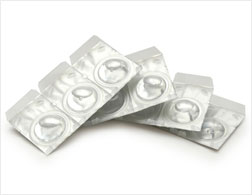Sure, there are going to be impacts associated with manufacturing contact lenses—for example, you need energy to run the factories (which will result in greenhouse gas emissions), and until soy-based contact lenses hit the market, you need petroleum to make the plastic. But the Lantern doesn't believe that contact lenses represent some kind of major, hidden environmental concern. However, as a lifelong four-eyes herself, she'll admit a certain curiosity about this question.

Let's start by estimating the amount of plastic that goes into a pair of contact lenses and a pair of eyeglasses. According to data collected in the early 2000s by Eurolens Research—an industry consulting group based at the University of Manchester—a single pair of soft contact lenses weighs about 25 milligrams after it's been dehydrated. Twenty-six pairs of your biweekly lenses, then, would produce about 0.65 grams of dried-out plastic. A year's worth of the Lantern's own daily disposables—that's 730 lenses total—would produce 9.125 grams of plastic—or a little less than would go into the production of two credit cards.
What about eyeglass lenses? The amount of material can vary, depending on the type of plastic used, the prescription, and the shape of the frame. But a reasonable estimate, according to the Minnesota-based manufacturer Vision-Ease Lens, might be 120 grams of plastic for a pair of blanks—little slabs that opticians can grind down into finished lenses—and 35 for lenses that come pre-finished from the manufacturer, and just need to be shaped to fit the frame. Consumers tend to buy new glasses every 2.2 years, but 35 grams of plastic is the equivalent of almost four years' worth of daily contacts, or more than 50 years' worth of biweeklies.
This calculation leaves out several important factors, though. As you note, contact lenses come with a lot of extra plastic paraphernalia, like bottles of solution, lens cases, and individual blister packs. Once you've accounted for all these, eyeglasses start looking much better. In a 2003 paper, the Eurolens researchers calculated how much waste contact lens wearers generate in a year.
They looked at one brand of daily disposables, which don't require cleaning, and one brand of monthly disposables, which are cleaned and stored at night. A year's worth of daily lenses—360 pairs, in this study—produced 953 grams of plastic, between the lenses themselves and the blister packaging. Twelve pairs of monthlies, with 12 carrying cases and 12 bottles of cleaning solution, produced 549 grams. (The researchers also tallied the metal used to seal the blister packs and the paper used in the boxes and instructional leaflets.)
Eyeglasses do come with their own accoutrements, but these hardly make a difference in the overall calculation. At this online shop, the heaviest pair of eyeglasses—with lenses included—weighs about 0.07 pounds. At Amazon.com, cases seem to max out at around 0.25 pounds. Even if you threw in a stack of chamois cloths, it seems unlikely that a pair of glasses would create more than a pound or so of consumer waste. Plus, most contact lens wearers need a pair of glasses, too—meaning they will almost always produce more trash.
For all that, it's not worth getting worked up over the impacts of contact lenses. A year's supply of dailies produces a total of about 3 pounds of plastic, metal, and paper trash; monthlies, about 2.5 pounds. By comparison, the average American generates an annual total of more than 1,600 pounds of garbage (PDF). And according to Philip Morgan, one of the co-authors of the Eurolens paper, companies have been steadily reducing the amount of plastic used in their bottles and blister packs—perhaps by as much as 10 percent or 20 percent.
Of course, the picture would get far more complicated if we stepped back and looked at the entire life cycle of each option. The Lantern's been able to collect some scraps of data on the topic—for example, Bausch & Lomb told her that making one pair of soft contact lenses produces approximately 0.29 pounds of carbon dioxide equivalent, and Vision-Ease has estimated that (in its Minnesota facility, at least) making a pair of eyeglass lenses produces 10.5 pounds of CO2-equivalent.
If those numbers can be trusted, wearing daily disposables for a couple of years would contribute 22 times more greenhouse gas emissions than wearing a pair of glasses over that time. However, there are still frames and plastic bottles and cardboard boxes to consider, not to mention the production of all the raw materials.
Lacking a proper cradle-to-grave accounting, then, concentrate on reducing your vision-related waste. Cardboard boxes and paper leaflets can be recycled, and solution bottles may as well, depending on what kind of plastic they're made out of. Double-check with your local waste agency before you put lens cases in the recycling bin, however—like prescription medicine bottles, they may be too small to be accepted.
Old eyeglasses can be donated via organizations like New Eyes for the Needy and Lions Clubs International, and you can send unopened, unexpired contact lenses to MADRE, an international women's human rights organization based in New York. (Your original prescriber may take them back, as well.) ( slate.com )
No comments:
Post a Comment